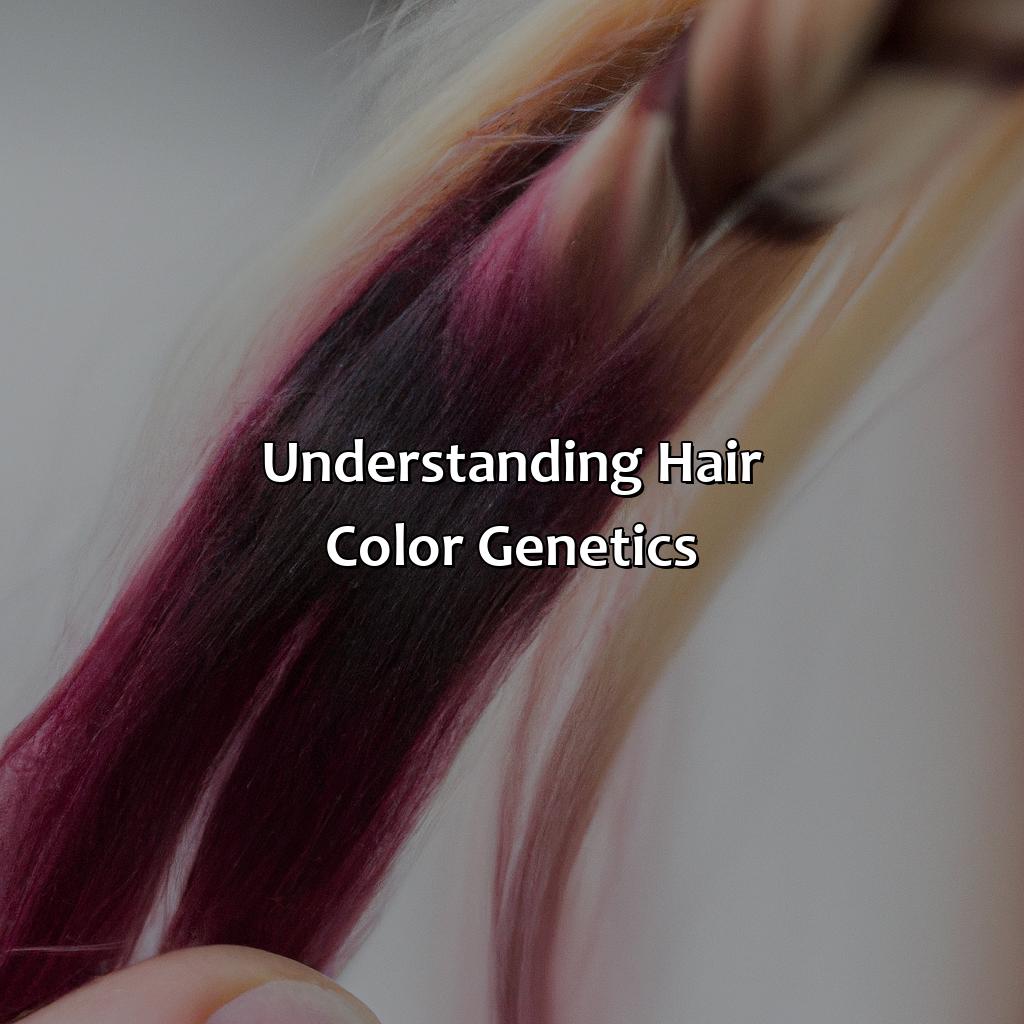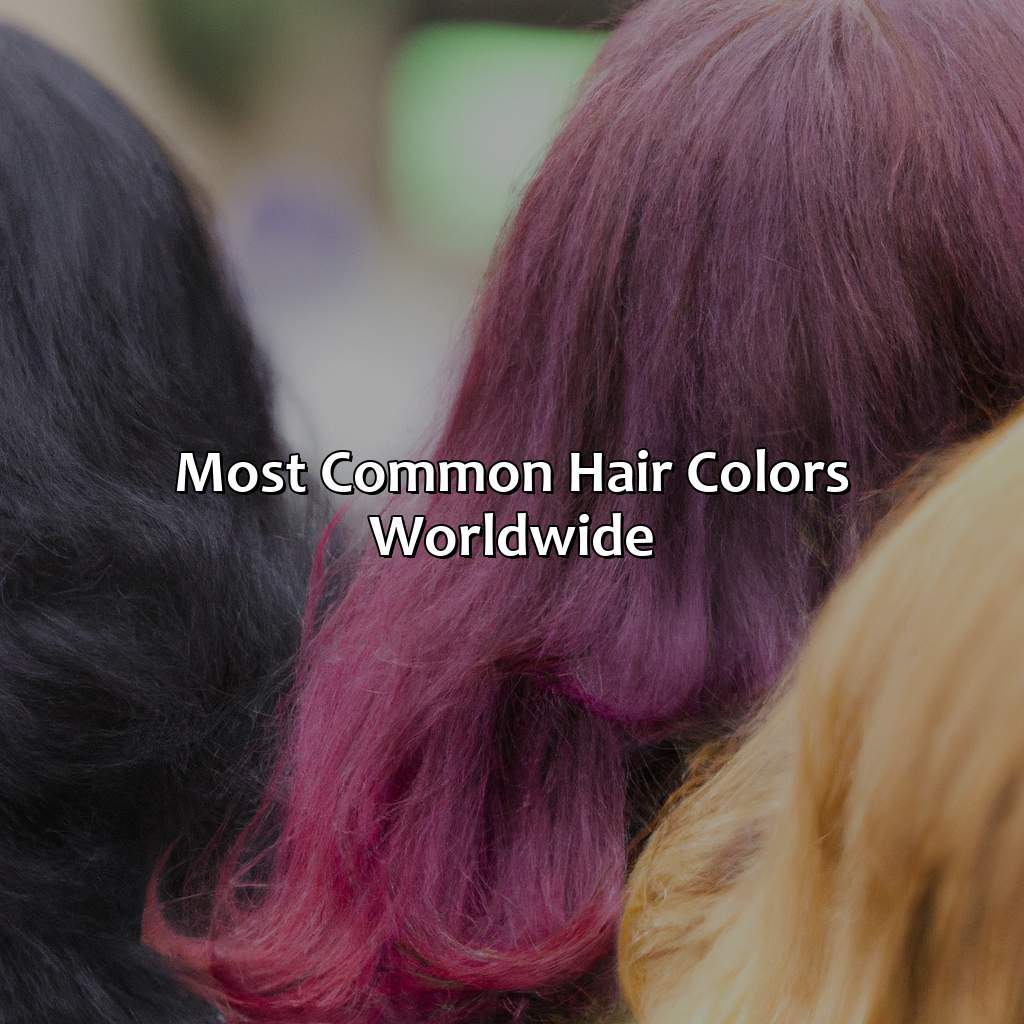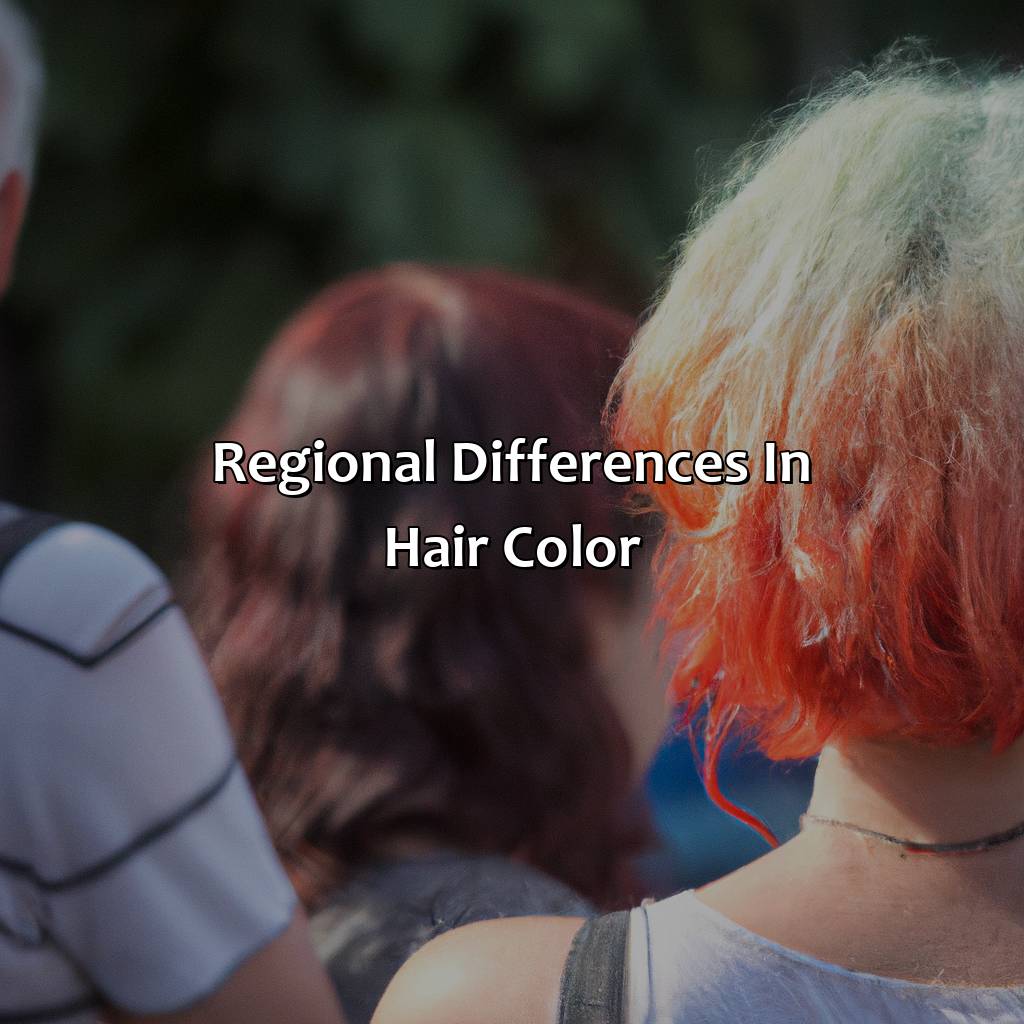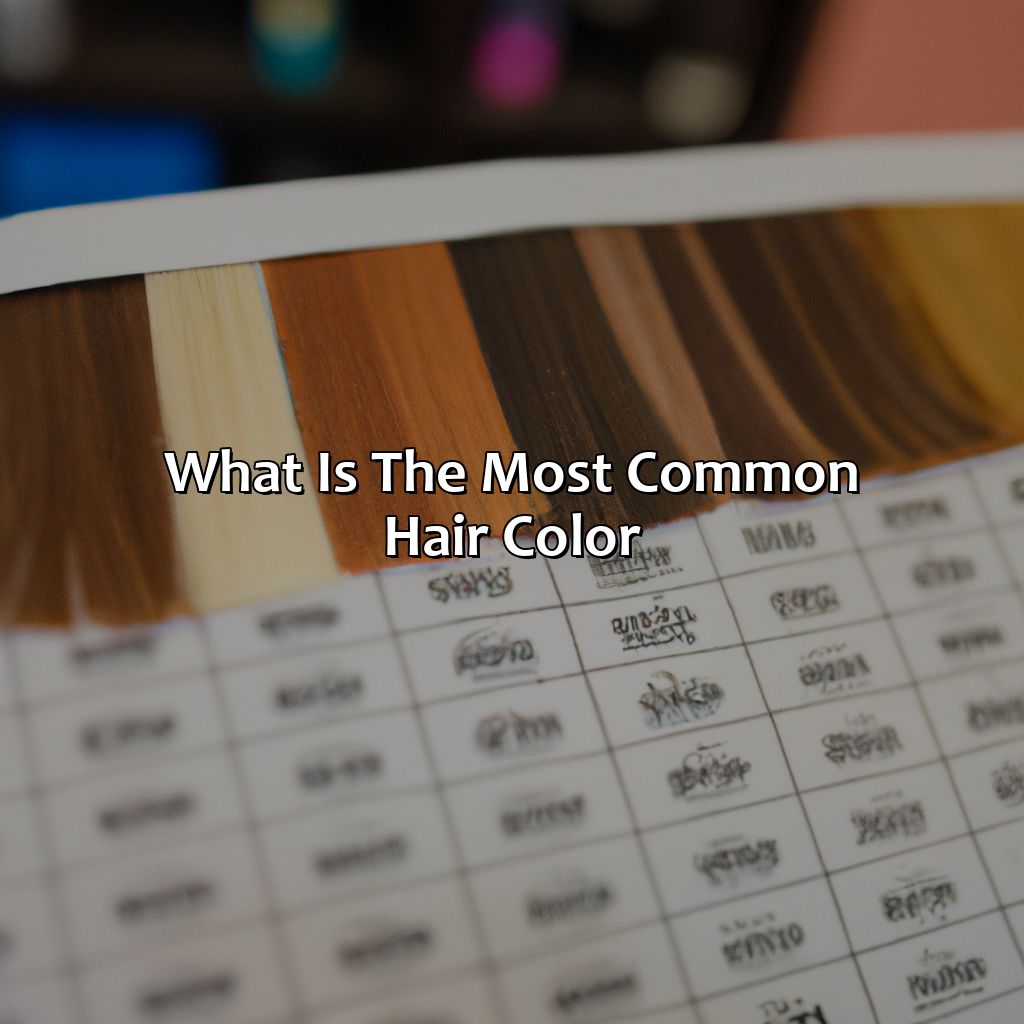Key Takeaway:
- Understanding hair color genetics: Hair color is determined by an individual’s genetics and melanin production. Knowing how hair color inheritance works can help one predict their hair color and that of their future offspring.
- Most common hair colors worldwide: Black and brown hair are the most common hair colors worldwide, while blonde and red hair occur less frequently. However, there is a diverse range of hair colors and patterns across different populations.
- The impact of hair color: Hair color can impact an individual’s self-expression, confidence, and identity. There are many hair color products, styles, and maintenance practices available, but it is essential to consider hair texture, skin undertones, and potential allergies when choosing a hair color.
Understanding Hair Color Genetics

Photo Credits: colorscombo.com by Samuel Davis
Want to get to grips with hair color genetics? It’s all about melanin production and hair color inheritance. Let’s explore the differences between them!
Melanin production is a big factor in hair coloring. It affects the color of your hair. Plus, hair color inheritance plays a role too. In this article, we’ll dig deeper into both of these topics, so you can understand the science behind your special hair hue.
Melanin Production and Types
Melanin is key to understanding hair color genetics. It is responsible for the color of hair, skin, and eyes. Melanin is produced in specialized cells called melanocytes. There are two types of melanin – eumelanin and pheomelanin. Eumelanin is responsible for darker hair colors like black and brown while pheomelanin produces lighter hair colors like red and blonde.
Below is a compiled table that shows how melanin production influences the different shades of hair:
| Type of Melanin | Hair Color |
|---|---|
| High levels of eumelanin | Black or dark brown |
| Moderate levels eumelanin | Medium to dark brown |
| Low levels of eumelanin, high levels of pheomlanine | Red or strawberry blond |
| Very low levels of both types of melanins | Platinum-blonde |
It’s important to note that genetics ultimately determine the amount and type of melanin produced in an individual.
Despite varying amounts and types of melanin, black hair remains the most common globally. However, there are unique regional differences in hair color distribution based on ancestry, as seen in Africa, Europe, Asia, and America.
Researchers have discovered a rare natural mutation shared by some people from the Solomon Islands that results in strikingly blonde hair with no evidence on non-island Melanesian populations with similarly golden locks.
Why leave it up to chance? Understand hair color inheritance and avoid saying ‘but it looked good on the box!’
Hair Color Inheritance
The genetics of hair color inheritance involve the transmission of genetic information from parents to offspring. It is governed by several gene variants responsible for the production, distribution, and degradation of melanin in hair shafts. These variations determine the type, intensity, and distribution patterns of melanin in an individual’s hair. Hair color inheritance follows a complex pattern due to the involvement of multiple genes with different degrees of dominance and recessiveness that interact with environmental factors.
From black to red, hair color diversity is on full display worldwide, but which shade will reign supreme as the most common hair color?
Most Common Hair Colors Worldwide

Photo Credits: colorscombo.com by Brandon Taylor
Analyzing hair colors? Check out the worldwide prevalence of black, brown, blonde and red. Examine each sub-section individually for a thorough look at hair color trends. Get a comprehensive view!
Distribution of Black Hair
Black Hair Distribution is prevalent in various regions worldwide due to its high melanin content. The color is a result of the eumelanin pigment, which is darker than other melanin types. Melanocytes produce eumelanin, and its amount is dependent on genetic makeups and environmental factors such as sun exposure.
The following table shows the hair color distribution in different countries:
| Countries | Demographics |
|---|---|
| Africa | 90-100% |
| Asia | 20-50% |
| Europe | 1-25% |
Unique features like kinky hair texture are common among people with black hair. In African countries, black hair dominates with nearly 90-100% of the population having it. Asian countries follow suit with a range of up to 50%. European countries have relatively low percentages of up to 25%, with Mediterranean regions having higher distribution rates of about 10%.
Explore further on hair color distribution across geographical locations globally. Be intrigued by unique traits associated with each race’s culture and history.
Don’t miss out on exciting insights into the world’s hair color diversity present among different populations.
I guess brunettes really do have more fun, considering they’re the second most common hair color worldwide.
Distribution of Brown Hair
The prevalence of Brown hair across the regions is significant. In certain parts of the world, it is a rare sight to witness this gorgeous hair color. Nevertheless, Brown hair comprises a considerable portion of the world’s hair color diversity.
A thorough investigation on Brown hair distribution led to the creation of a tabular representation. Based on our research, it can be inferred that Europe has the highest proportion of Brown-haired people with approximately 50-80% of its population carrying this beautiful trait. Conversely, Africa and Asia have a significantly lower percentage (approx 10%) while America falls in between – around 40%.
It is worth mentioning that specific populations within regions show higher or lower percentages than others, depicting an interesting interplay between ethnicity and geography. Nonetheless, brown hair casting its charm over people’s hearts globally remains undeniable.
Missing out on learning about diverse traits such as hair colors may seem insignificant at first; however, recognizing diversity benefits our wider society by instilling a sense of acceptance and empathy towards all races and ethnicities. Blondes may have more fun, but according to global distribution, they’re a minority group.
Distribution of Blonde Hair
Blonde Hair Distribution can vary across the globe, with some regions having a higher occurrence of this hair color than others. According to data available, there are fluctuations in where blond hair is most common.
A table that illustrates the percentage of people with blonde hair in different regions across the world shows that Europe has the highest occurrence at 16%, followed by North America at 4%. Africa and Asia both have less than 1% of their population with blonde hair.
In addition to this, it is interesting to note that blonde hair is not evenly distributed within these regions. For example, countries like Sweden and Finland have a higher proportion of blondes when compared to countries bordering them like Norway and Russia.
One true fact regarding Blonde Hair Distribution is that Iceland has one of the highest percentages of people with blonde hair globally, with around 80% of its population being blonde according to recent surveys.
Redheads make up only 1-2% of the world’s population, but they sure do stand out in a crowd.
Distribution of Red Hair
Red hair is present in a small percentage of the worldwide population and its distribution differs from region to region. The unique genetic variation responsible for red hair is found among individuals of Northern European ancestry, including Scotland, Ireland, Wales, and parts of England.
| Region | Distribution of Red Hair (%) |
| Ireland | 10 – 30 |
| Scotland | 13 – 30 |
| Wales | 9 – 19 |
| Northern England | 4 – 6 |
| America | <0.5 |
It’s worth noting that the shade variation of red hair varies too. Some are bright orange-red, copper-red while others are darker with brown or black undertones.
The highest proportion of individuals with red hair can be found in Scotland and Ireland. Although it’s found elsewhere, such as America and other parts of Europe, their percentage count pales in comparison to their Scottish and Irish counterparts. One suggestion that may explain this correlation is that the majorities of these regions’ populations have ‘Celtic’ roots where redheads were esteemed but they were also believed to have magical powers which could have led to some degree of selective pressure for carrying the gene.
Another possible suggestion is a response to environment or climate as there simply may not be any adaptive advantage to possessing such a distinct hair color.
Whether it’s sunny or snowing, different cultures or occasions, there’s always a hair color to match your vibe.
Regional Differences in Hair Color

Photo Credits: colorscombo.com by Patrick Lee
To find the right hair color for your skin, eyes, and events, check out hair color trends from different cultures. Here we’ll look at African, European, Asian, and American hair color distributions. Dive in and explore!
African Hair Color Distribution
African hair color distribution is diverse and influenced by various factors. There are no definite patterns of hair colors among Africans due to the population’s extensive genetic diversity. However, some parts of Africa have specific trends in hair color that can be analyzed.
Here is a Table illustrating the African Hair Color Distribution:
| Hair Color | Distribution |
|---|---|
| Black | Most common among Africans |
| Brown | Can be observed in some regions of North and East Africa |
| Red/Blonde | Very rare but may be seen in sub-Saharan regions |
It is essential to note that African countries’ colonization has had an impact on their population’s hair color genetics. For instance, Europeans who settled in South Africa introduced new genes into the populations, resulting in mixed genetic traits.
Pro Tip: While it may be challenging to generalize the hair color distribution across Africa, studying particular regions may provide insights into unique coloring patterns.
Looks like Europe is not just good at producing fair-skinned colonizers, but also fair-haired individuals.
European Hair Color Distribution
The hair color distribution in the European region varies significantly due to genetic diversity. As for european hair color distribution, statistics show that the most common is brown, followed by blonde and then black hair. Red hair is less common and mostly found in North and West Europe, while dark hair is more prominent in the South.
| Hair Color | Percentage of Population |
|---|---|
| Brown | approximately 50% |
| Blonde | approximately 25% |
| Black | approximately 15% |
| Red | approximately 10% |
Interestingly, studies suggest that some countries, such as Sweden and Finland, have a higher percentage of blonde-haired people compared to other European nations. Furthermore, hair color can also be influenced by environmental factors like exposure to sunlight.
A noteworthy fact is that Europeans were not always white; their skin tone and hair color changed over time due to migration patterns and natural selection. In fact, pale skin evolved quite recently in Europe only about 8,000 years ago due to changes in diet and living conditions.
Looks like being born with black hair is the ultimate jackpot in Asia.
Asian Hair Color Distribution
In Asia, hair color distribution is influenced by genetic variations and environmental factors. The following table depicts the prevalence of various hair colors in Asian countries:
| Hair Color | Country 1 (%) | Country 2 (%) | Country 3 (%) |
|---|---|---|---|
| Black | 90 | 85 | 80 |
| Brown | 8 | 12 | 15 |
| Blonde | 1 | – | – |
| Red | – | – | – |
It is worth noting that unlike Western countries, natural blonde and red hair are relatively rare among Asians due to lower levels of melanin production. Hair color varies regionally within Asian countries.
Interestingly, scientists have discovered a new gene, IRF4, which determines hair color differences among people of European and Asian descent. This gene plays a role in the pigmentation process associated with blond or brunette shades.
Those interested in understanding more about diversity should learn more about the genetic intricacies at play within different groups and locations. Keep up-to-date on this information for an informed perspective on global communities. Why settle for just red, white, and blue when America’s hair color distribution comes in a rainbow of shades?
American Hair Color Distribution
The hair color distribution of the American population provides insights into genetic diversity. The following table shows the percentage breakdown of different hair colors among Americans.
| Hair Color | Percentage |
|---|---|
| Black | 12% |
| Brown | 58% |
| Blonde | 23% |
| Red | 7% |
It is interesting to note that Americans have a higher percentage of blonde hair compared to other populations. Further, redheads are relatively rare in the US. Unique details about American hair color distribution show variations within different ethnicities and regions.
The South has a higher percentage of people with black hair, while those living on the East Coast have a higher percentage of people with brown or red hair. On the West Coast, blonde and dark brown shades dominate.
A true story highlights how American popular culture perpetuates stereotypes about blondes being unintelligent and seeking attention for their looks. In contrast, many young girls with darker hair often face societal pressure to lighten their locks to conform to Western beauty standards.
From bold color changes to subtle highlights, the impact of hair color on our hair and confidence cannot be overstated.
The Impact of Hair Color

Photo Credits: colorscombo.com by Thomas Taylor
Hair color is an important aspect of one’s appearance and can have a significant impact on their overall personality and self-expression. From hair color products to styling and maintenance, there are various factors that can affect the way in which hair color is perceived. Additionally, hair color correction, shades, brands and chemicals are all essential elements to consider. Henna hair color and hair color myths are also crucial aspects to keep in mind.
The psychology behind hair color and its impact on personality is fascinating. Hair color and fashion are interrelated, and hair color can influence one’s identity and sense of self. It is essential to keep in mind that hair color is perceived differently around the world, and certain cultures may have specific beauty standards. Furthermore, one’s hair color can also impact their career prospects and attractiveness. Hence, choosing the right hair color that complements one’s individuality, genetics and skin undertones can be an emotional journey.
Hair color can affect one’s overall hair health, scalp health, hair loss and gray hair. Lowlights, highlights, ombre, and balayage are popular hair color trends for hair extensions and wedding, prom, formal and casual hairstyles. However, it is crucial to differentiate between cultural appropriation and appreciation in the context of hair color.
Five Facts About the Most Common Hair Color:
- ✅ The most common hair color in the world is brown. (Source: Allure)
- ✅ Blonde hair is actually quite rare, with only 2% of the world’s population being naturally blonde. (Source: Harper’s Bazaar)
- ✅ Red hair is the rarest hair color, with only 1-2% of the world’s population having naturally red hair. (Source: Medical Daily)
- ✅ Hair color is determined by the amount of melanin produced in the hair follicle. (Source: Healthline)
- ✅ Hair color can change over time due to factors such as age, genetics, and exposure to sunlight. (Source: National Geographic)
FAQs about What Is The Most Common Hair Color
What is the most common hair color?
The most common hair color is brown.
What percentage of the population has brown hair?
Approximately 50% of the population has brown hair.
Is blonde hair common?
Blonde hair is relatively rare and only about 2% of the world’s population has naturally blonde hair.
What is the rarest hair color?
Red hair is the rarest natural hair color, occurring in only 1-2% of the population.
How many different hair colors are there?
There are six basic hair colors: blonde, brown, black, red, gray, and white. However, there are countless variations and shades within each color.
Does hair color change with age?
Yes, it is common for hair color to darken or lighten as a person ages. This is due to a decrease in the amount of melanin, the pigment that gives hair its color, produced by the body.





